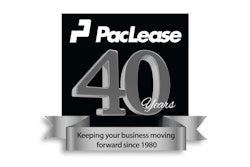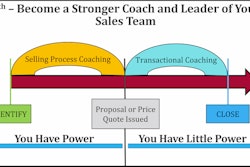

Ideally, those sales associates would land clients on their own, but in instances when they needed just a little more help reeling in a big fish, sales managers would step in. They’d cut prices and offer discounts for services to help lock down business, only to retreat back to their offices once a contract was signed.
This method worked for decades. It likely still works now in some businesses. But during a webinar presented Thursday by the Commercial Vehicle Solutions Network (CVSN), Professional Sales Consultant Jim Pancero says today’s sales managers should be shifting their priorities away from closing and more toward coaching, teaching and leading.
For old-school sales managers who are still taking the ball in the ninth inning to finish sales, Pancero says shifting one’s priorities from selling to coaching isn’t quite as hard as it may seem. The key is a shift in mindset. Rather than reactively assisting salespeople when in need, Pancero says sales managers should instead work to actively motivate and train employees daily so they can close sales and lock down business on their own.
He believes one way for sales managers to determine how much of their workload needs to change is to break down their responsibilities into reactive/supportive and proactive/growth categories. He says managers spend their time reactively supporting team members; leaders proactively coach their employees to be better.
“Where are you spending your time?” Pancero asks, adding “call me if you need me” shouldn’t be the only guidance a salesperson ever receives.
“The job of a sales manager is to help your people achieve more than they would have achieved if you left them alone,” he says.
Pancero says a good place for sales managers to start changing their approach is to focus on sales processes.
Leaders get involved with their sales associates before they ever meet a client, offering guidance for dealing with customers or positioning products in front of customers. Leaders also check in with employees after sales calls and offer consultative advice on how a salesperson can better their approach in the future. They don’t just walk in last minute and offer a margin-killing 10 percent discount.
Sales leaders also remember to be positive. Pancero says young sales associates will make mistakes and lose sales sometimes. But he says berating them for those mistakes won’t motivate them to be better the next day. He says constructive criticism that looks at where a sales breaks down and discovers ways to change a salesperson’s messaging is a much more positive away to approach a bad situation.
Pancero adds effective coaching requires patience, and “is based on successful questioning and challenging skills in a positive environment.” It requires leaders to get into what Pancero calls the ‘Coaching Zone.’
“The Coaching Zone is when you can keep the conversation [with a sales rep] future-focused, tactical, strategic and operational,” he says. “We want them to be able to think three and four moves ahead.”
He went on to close Thursday’s webinar with four keys to move effective sales leadership forward:
- Define “selling process” tools and processes.
- Become more involved in “selling process” management through one-on-one account planning.
- Be more active in training and coaching employees to use selling processes, tools and skills.
- Use a single performance dashboard to measure selling process progress and success.
Together, Pancero says these keys measure a change in attitude, effort, progress and results. And in today’s uncertain business climate, never has it been more important for sales managers to stay engaged.
“I think now you need to be three times as connected to your people if you were before,” he says. “That means if you were checking with them once a week, now it should be three times a week. You need to stay connected so you don’t lose them.”










